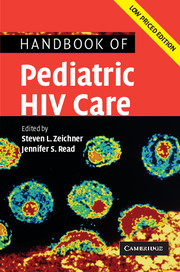Book contents
- Frontmatter
- Contents
- List of contributors
- List of abbreviations
- Foreword
- Preface
- Part I Scientific basis of pediatric HIV care
- Part II General issues in the care of pediatric HIV patients
- 3 Diagnosis of HIV infection in children
- 4 Prevention of mother-to-child transmission of HIV
- 5 Routine pediatric care
- 6 Emergency evaluation and care
- 7 Adherence to antiretroviral therapy in children and youth
- 8 Adolescents and HIV
- 9 Growth, nutrition, and metabolism
- 10 Neurobehavioral function and assessment of children and adolescents with HIV infection
- Part III Antiretroviral therapy
- Part IV Clinical manifestations of HIV infection in children
- Part V Infectious problems in pediatric HIV disease
- Part VI Medical, social, and legal issues
- Appendix 1 Formulary of antiretroviral agents
- Appendix 2 National Institutes of Health sponsored clinical trials for pediatric HIV disease
- Appendix 3 Selected HIV-related internet resources
- Appendix 4 Selected legal resources for HIV-infected children
- Index
- References
3 - Diagnosis of HIV infection in children
Published online by Cambridge University Press: 23 December 2009
- Frontmatter
- Contents
- List of contributors
- List of abbreviations
- Foreword
- Preface
- Part I Scientific basis of pediatric HIV care
- Part II General issues in the care of pediatric HIV patients
- 3 Diagnosis of HIV infection in children
- 4 Prevention of mother-to-child transmission of HIV
- 5 Routine pediatric care
- 6 Emergency evaluation and care
- 7 Adherence to antiretroviral therapy in children and youth
- 8 Adolescents and HIV
- 9 Growth, nutrition, and metabolism
- 10 Neurobehavioral function and assessment of children and adolescents with HIV infection
- Part III Antiretroviral therapy
- Part IV Clinical manifestations of HIV infection in children
- Part V Infectious problems in pediatric HIV disease
- Part VI Medical, social, and legal issues
- Appendix 1 Formulary of antiretroviral agents
- Appendix 2 National Institutes of Health sponsored clinical trials for pediatric HIV disease
- Appendix 3 Selected HIV-related internet resources
- Appendix 4 Selected legal resources for HIV-infected children
- Index
- References
Summary
Effective management of pediatric HIV-1 infection begins with timely and accurate diagnosis. In infants, early diagnosis is essential. Life-threatening immunodeficiency can develop rapidly and unpredictably, and there are no laboratory or clinical characteristics that accurately predict rapid or slow disease progression [1]. Studies in adults and children have shown that very early treatment can slow the progression of immunodeficiency and preserve HIV-1-specific immune responses. Early detection of HIV-1 infection among pregnant women is necessary to optimize medical care for the HIV-1-infected woman and to prevent mother-to-child transmission of HIV-1. This chapter outlines the use of serology, virus culture, and molecular diagnostic methods to detect HIV-1 infection.
HIV-1 Diagnostic assays
Detection of antibodies to HIV-1
In 1985, enzyme-linked immunosorbent (ELISA) and immunoblot (Western blot) assays were licensed in the United States for detection of HIV-1-specific IgG antibodies in serum. While other tests are now available, they remain the mainstay for serological diagnosis of infection.
ELISA assays detect all antibodies that react with HIV-1 proteins, and are an excellent method for rapid screening. Moreover, minor modifications, such as dilution of the test samples, allow samples with low antibody titers to be identified. This “detuned ELISA” has been successfully used to identify adults with recently acquired HIV-1 infection [2, 3]. In a high-risk population for HIV-1, the positive predictive value of ELISA testing is reported to exceed 99%. However, false-positive reactions still occur (see below), particularly when used in populations at low risk for HIV-1 infection.
- Type
- Chapter
- Information
- Handbook of Pediatric HIV Care , pp. 99 - 106Publisher: Cambridge University PressPrint publication year: 2006

